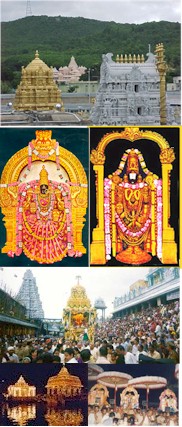Welcome to Adiyen Sri Ramanuja Dasan !
" Srimathe Ramanujaya Namaha !"
Ananda Nilaya Vimanam and its 7 Renovations
VIMANAS AND ANANDA NILAYA VIMANAM.
In India, the ultimate aim of life is Release (Moksha), and art is one means of attaining this aim and Moksha is a reintegration into the Absolute, (i.e. one with Him) and this art found the temples and statues. These temples are so many stages in approach to moksha. They are halting places, providing rest and support for one unanimous Tradition, that flows through the word of the Veda and is borne along by the ritual in invisible and multifold patterns. Further there is a saying "no temple, no village"and so we find that in ancient India whether it be a place of tradition,a hamlet or a city, any place had a temple of its own. The maintenance of a temple was considered very sacred and they were looked upon as a sign of prosperity. It is also said that men ought not to live in places where there are no temples and the Tevaram mentions that places without Temples are unfit for purposes of residence, and they are merely deserts. It is also believed that- the land will not be visited by famine and pestilence as long as the temples are well maintained by the ruling race.
It is therefore we find temples in most of the villages in this country. Almost all the members of the ruling race associated themselves with these temples, either by way of repairing or making endowments or in the construction of temples etc. These temples, by the splendour of their massive structure and fine sculpture, prompt the worshippers to lead a life of purity and devotion. Again, these were the great centres of learning in ancient India. Further, the temple served as a mirror in which the sociopolitical conditions of the land were reflected and there are good many instances to show, that it was these temples that saved the people from the jaws of famine and pestilence by selling away the temple property and financing the people.
The root of all these lie in Bhakti, " an affection fixed upon the Lord " and there is no wonder that there were several works on religious Art and Architecture and even " the Silpis are instructed to take particular note of their construction, on pain of committing worst sins and submitting themselves to the crudest of divine visitations and punishments."
There are many works in Sanskrit which deal with temple construction, Idol worship, iconography and such other topics. At one time it was believed that there were as many as 1,20,00,000 granthas or stanzas on the subject and MANASARA is the most perfect one, having eloborate and exhaustive details chiefly for temple or sacred Architecture. The word ' Manasara ' means that it was written by one Manasara and it may also be interpreted as a science of the essence of measurements. The class of people who exclusively practice Silpa Sastra claim Viswakarma, the divine architect, as their ancestor.
Jai Srimannaryana !
Thanks for your valuable time. Visit our web site again for more information and latest updates.

